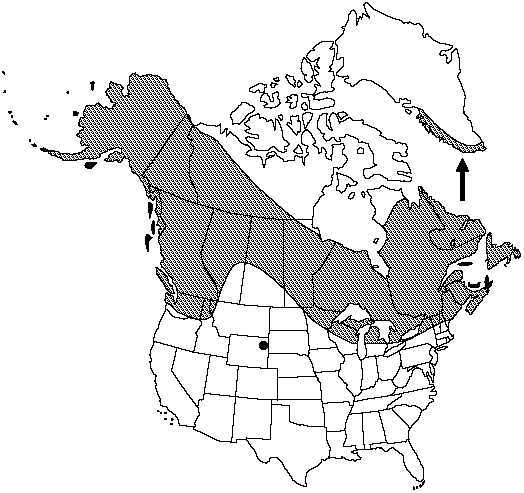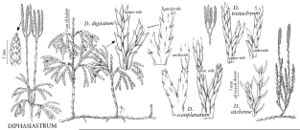Diphasiastrum complanatum
Preslia 47: 108. 1975.
Horizontal stems on substrate surface or shallowly buried in litter, 1.1–2.2 mm wide; leaves appressed, linear to narrowly lanceolate, 1.4–4 × 0.5–1.2 mm, apices acute. Upright shoots 8–44 cm, branching irregularly successively to 5 times; leaves on upright main stem appressed with decurrent base, narrowly lanceolate, 1.2–3.2 × 0.5–1.1 mm, apex acute to acuminate. Branchlets flat in cross section, narrowly bladelike, 1.8–4 mm wide, annual bud constrictions abrupt and conspicuous; upperside green, faintly shiny, flat; underside dull, pale, flat. Leaves on branchlets 4-ranked; upperside leaves appressed, linear-lanceolate, free portion of blades 0.7–2 × 0.5–1.2 mm; lateral leaves appressed, 2.6–7.3 × 0.8–2.1 mm; underside leaves weakly developed, appressed, narrowly deltate, 0.7–1.5 × 0.4–0.9 mm. Peduncles 1–2 on each upright shoot, 0.5–8.5 × 0.4–0.9 cm; leaves spirally arranged to nearly whorled, linear-lanceolate, 1.4–4.1 × 0.4–1 mm, apex acute to blunt. Stalks forked at uniform distances. Strobili 1–2(–4), 8.3–32 × 2–3 mm, apex blunt, sterile tip absent. Sporophylls broadly deltate to nearly cordate, 2–3 × 2–2.4 mm, apex abruptly tapering. 2n = 46.
Habitat: Dry open coniferous or mixed forest alpine slopes
Elevation: 0–2000 m
Distribution

Greenland, St. Pierre and Miquelon, Alta., B.C., Man., N.B., Nfld. and Labr., N.W.T., N.S., Nunavut, Ont., P.E.I., Que., Sask., Yukon, Alaska, Idaho, Maine, Mich., Minn., Mont., N.H., N.Y., Vt., Wash., Wis., Wyo., circumboreal.
Discussion
Diphasiastrum complanatum forms a hybrid with D. digitatum that is seemingly uncommon and has never received a binomial designation. It is probably far more common than collections indicate, however. Superficially, the hybrid resembles both parents and is often confused with them. Collections are known from Ontario, Quebec, Connecticut, Maine, Michigan, Minnesota, New Hampshire, Vermont, and Wisconsin.
Selected References
None.
